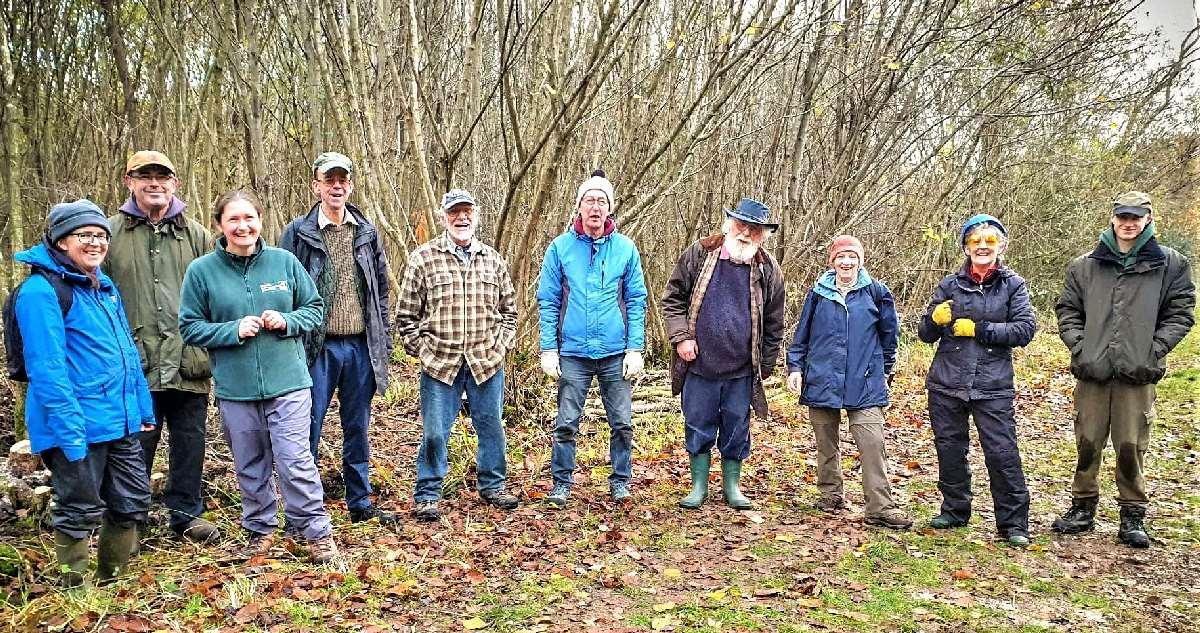
5 minute read
Going Coppicing with BBOWT Trainers
On 6 December a group of tree enthusiasts set off for a day’s training in coppicing, organised by BBOWT (Berks, Bucks and Oxon Wildlife Trust). The three from Launton (Ed Hamill, Mick Jennion, and Robert Cornford) were put forward by the Friends of Island Pond Wood where all have volunteered for working parties.
The training was held at Rushbeds Wood, between Brill and Wootton Underwood, but the initial meet-up was at Meadow Farm Nature Reserve just outside Blackthorn on the Thame Road.
It was a cold morning (but not as cold as a week later) and sunny. The Meadow Farm meeting room was warm with a blazing woodburner stove, but it was only used by the group for about 10 minutes before we set off into the cold morning.
Rushbeds Wood is alongside the main line Chiltern line to Marylebone, but once we were in the depths of the woodland we weren’t aware of the trains.
Led by Veritie Turner, the BBOWT Community Wildlife Officer for Banbury and Bicester, the group of eight trainees and two trainers set off into the woodland. Most of the trees in Rushbeds Wood were felled in the late 1940s, and only a handful of mature oaks remain. Today's 'wildwood' is a mixture of ash, field maple, aspen, hazel and oak along with blackthorn, hawthorn, spindle and a few old hornbeams. Underfoot, the woodland is damp and tussocky with a wide variety of mosses, sedges, grasses and rushes. We started with an introduction to coppicing- a woodland management system that has been in use for over 3,000 years. It produces an endless supply of wood - from a variety of trees including hazel, ash, elder, oak, wych-elm, lime, and hornbeam.
In the past the wood poles were used for making hurdles and fences, for furniture and building, for tools, for making charcoal used in metal smelting and as a domestic fuel, and - of course - for firewood. Today it is more often used for woodland management, to open up woodland areas for light and shade, and to create healthy woods. Coppicinginvolves cutting down a tree to close to ground level, and letting the stump send up new shoots and becomes a stool from which successive crops of poles can be cut for ever. This doesn’twork for pine or fir trees which die when cut down, and other trees (aspen, cherry and most elms) sucker so the stump dies but the root system remains alive and throws up successive crops of poles in a patch of genetically identical trees. Pollardingis a similar system of management, but involves cutting at between 2 and 4.5 metres off the ground which leaves a permanent trunk, and a crop of shoots that grow into poles: around here it is most often used on willows.
After the talk we were issued with our tools (a pruning saw and a bow saw if it was needed, and a bill hook). We mainly used the pruning saws - and steered clear of the bill hooks as you needed to use them without gloves, and it was quite cold even in the sunshine. We were all given an area to work on - a few very overgrown hazels - and told not to work under any of the big, old ash trees in the woodland as there is Ash Diebackin the area, and infected trees can suddenly shed branches.
The specialists reckoned that the area we were working in had seen no human activity for at least 40 years - so there were some fallen trees, some very long and whippygrowths, and a lot of rotting wood underfoot. The work meant cutting down all the growth from each stump or stool, cutting from the underside to make an angled cut that would shed water. When finished, a stump should look like a dome.
The group was working in an untouched part of the woodland, to create a clear space of coppicedstumps (a coupe) that would then be fenced off to protect the shoots from predators like deer, rabbits, and grey squirrels. The brash off-cuts from the coppicingwas used to create informal hedges, and longer (2.5m) and straighter poles were put aside to make posts for deer fencing later
Two hours of work, then a packed lunch and drinks, then two more hours coppicing then the photo below, and as it was beginning to get dark, we cleared up and made our way home. We were told that next morning we would be aware that we’d done some unusual exercise - and this was true: shoulders and arms and thighs all knew that we’d engaged in some serious physical activity.
Now, we can't wait to get to work coppicing in the Island Pond Wood.
Robert Cornford

The group of volunteers, with the two trainers, 3rd from the left and far right
BBOWT



